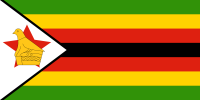Zimbabwe

Zimbabwe occupies 390,757 km² of land in south central Africa, between the Limpopo and Zambezi rivers. The land-locked country is bounded by Mozambique to the east, Zambia to the north and north west, South Africa to the south, and to the south west by Botswana. It lies wholly within the tropics and is part of the great plateau which traverses Africa.
The climate of Zimbabwe is temperate. The winter season from May to August is cool and dry, with temperatures between 13 to 20 degrees Celsius. Summer, which is from December to February temperatures vary between 25 and 30 °C and the rainy season normally stretches from November to March. Parts of the country suffer regular periods of drought.The average monthly rainfall is 196mm in summer and 10mm in winter.
Zimbabwe has a population of 12,754,000 (latest census). The official and business language is English, with Shona and Ndebele also widely spoken. Harare is the capital city of Zimbabwe, a vital commercial and industrial business Centre; other centres include Bulawayo and Mutare. Formerly Southern Rhodesia, Zimbabwe attained independence from Britain in 1980. Elections are held every 5 years and the President is the Head of State.
Zimbabwe's economy is dependent on agricultural products including tobacco, cotton and sugar cane. Major export commodities are tobacco and horticulture. Smaller crops like sugar, tea, coffee, cotton, seeds, maize, small grains and oilseeds are also exported. The sector is an important contributor to the country’s export activities, with markets in America, Europe, Africa and the Far East. Mining contributes 4.3 % to Gross Domestic Product (GDP), employs 7 % of the country’s labour force and earns 40 % of the foreign exchange. Zimbabwe is richly endowed with mineral resources, over 40 different types of minerals are mined in the country, including the major minerals gold, chrome, asbestos, coal, iron ore, nickel, copper, diamonds and platinum. Other contributors to the economy are industry and cattle farming. The principal manufactured exports include ferro-alloys, clothing, metal products, chemicals, plastics and cotton-lint. Livestock agriculture (cattle) is one of the country’s foremost economic activities. At present Zimbabwe is facing severe socio-economic difficulties including hyper-inflation, negative real interest rates, and a chronic shortage of foreign exchange.
Tourism contributes about 5 % of GDP and directly and indirectly employs over 83,000 people. Zimbabwe has one of the more diversified tourism resource bases in the SADC region. However, despite all its tourist attractions, very limited development has occurred since 1996 owing to inadequate support and few promotional activities for the sector. Wildlife and ecotourism are the mainstays of the sector but, in addition, the majestic Victoria Falls, the Great Zimbabwe National Monument, home tothe ancient rulers of Zimbabwe, the Matopos National Park, Lake Kariba, Mana Pools, and the scenic Eastern Highlands are some of the most favoured tourist sites.

